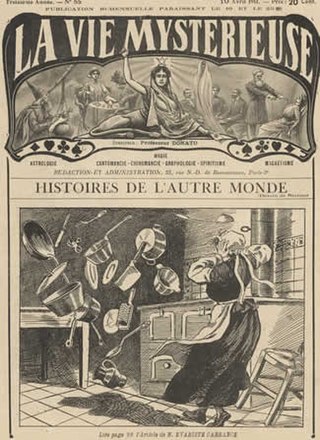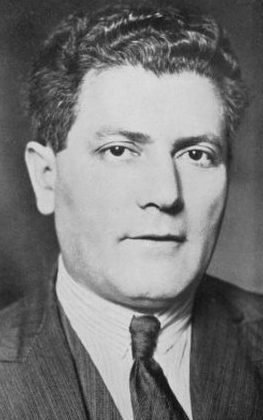Related Research Articles

Parapsychology is the study of alleged psychic phenomena and other paranormal claims, for example, those related to near-death experiences, synchronicity, apparitional experiences, etc. Criticized as being a pseudoscience, the majority of mainstream scientists reject it. Parapsychology has also been criticised by mainstream critics for claims by many of its practitioners that their studies are plausible despite a lack of convincing evidence after more than a century of research for the existence of any psychic phenomena.

In ghostlore, a poltergeist is a type of ghost or spirit that is responsible for physical disturbances, such as loud noises and objects being moved or destroyed. Most claims or fictional descriptions of poltergeists show them as being capable of pinching, biting, hitting, and tripping people. They are also depicted as capable of the movement or levitation of objects such as furniture and cutlery, or noises such as knocking on doors. Foul smells are also associated with poltergeist occurrences, as well as spontaneous fires and different electrical issues such as flickering lights.

Telepathy is the purported vicarious transmission of information from one person's mind to another's without using any known human sensory channels or physical interaction. The term was first coined in 1882 by the classical scholar Frederic W. H. Myers, a founder of the Society for Psychical Research (SPR), and has remained more popular than the earlier expression thought-transference.
In American science fiction of the 1950s and 1960s, psionics was a proposed discipline that applied principles of engineering to the study of paranormal or psychic phenomena, such as extrasensory perception, telepathy and psychokinesis. The term is a portmanteau formed from psi and the -onics from electronics. The word "psionics" began as, and always remained, a term of art within the science fiction community and—despite the promotional efforts of editor John W. Campbell, Jr—it never achieved general currency, even among academic parapsychologists. In the years after the term was coined in 1951, it became increasingly evident that no scientific evidence supports the existence of "psionic" abilities.
Celia Elizabeth Green is a British parapsychologist and writer on parapsychology.

William G. Roll was an American psychologist and parapsychologist on the faculty of the Psychology Department of the University of West Georgia in Carrollton, Georgia. Roll is most notable for his belief in poltergeist activity. He coined the term "recurrent spontaneous psychokinesis" (RSPK) to explain poltergeist cases. However, RSPK was never accepted by mainstream science and skeptics have described Roll as a credulous investigator.
Dream telepathy is the purported ability to communicate telepathically with another person while one is dreaming. Mainstream scientific consensus rejects dream telepathy as a real phenomenon. Parapsychological experiments into dream telepathy have not produced replicable results. The first person in modern times to claim to document telepathic dreaming was Sigmund Freud. In the 1940s, it was the subject of the Eisenbud-Pederson-Krag-Fodor-Ellis controversy, named after the preeminent psychoanalysts of the time who were involved: Jule Eisenbud, Geraldine Pederson-Krag, Nandor Fodor, and Albert Ellis.

Henry Addington Bayley Bruce, best known as H. Addington Bruce was an American journalist and author of psychology books.

Anomalistics is the use of scientific methods to evaluate anomalies, with the aim of finding a rational explanation. The term itself was coined in 1973 by Drew University anthropologist Roger W. Wescott, who defined it as being the "serious and systematic study of all phenomena that fail to fit the picture of reality provided for us by common sense or by the established sciences."
Douglas Scott Rogo was a writer, journalist and researcher on subjects related to parapsychology. Rogo was murdered in 1990 at the age of 40. His case remains unsolved.
The American Society for Psychical Research (ASPR) is the oldest psychical research organization in the United States dedicated to parapsychology. It maintains offices and a library, in New York City, which are open to both members and the general public. The society has an open membership, anyone with an interest in psychical research is invited to join. It maintains a website; and publishes the quarterly Journal of the American Society for Psychical Research.
Guy Lyon Playfair was a British writer, best known for his books about parapsychology and his investigation of the Enfield poltergeist.
Rudolf Tischner was a German ophthalmologist and parapsychologist born in Hohenmölsen. After finishing his medical studies he practiced ophthalmology in Munich.

Nandor Fodor was a British and American parapsychologist, psychoanalyst, author and journalist of Hungarian origin.

Walter Franklin Prince was an American parapsychologist and founder of the Boston Society for Psychical Research in Boston.

Anthony Donald Cornell was a British parapsychologist and prominent figure in the investigations of ghosts and other paranormal activity across the United Kingdom during the later part of the twentieth century. He appeared in numerous TV documentaries and television debates, and was often the subject of magazine and news articles concerning ghosts and paranormal investigations.
In psychology, anomalistic psychology is the study of human behaviour and experience connected with what is often called the paranormal, with few assumptions made about the validity of the reported phenomena.

Charles Edward Mark Hansel was a British psychologist most notable for his criticism of parapsychological studies.
Loren Rhoads is a San Francisco-based author, editor, and lecturer on cemetery history. She is a member of Horror Writers Association, Science Fiction and Fantasy Writers of America, and the Association for Gravestone Studies.
References
- 1 2 Markoff, John (1994-03-27). "Sound Bytes; An Electronic Salon, in N.Y." The New York Times .
- 1 2 3 4 "Stacy Horn » About". stacyhorn.com. 31 July 2008. Retrieved 28 April 2011.
- ↑ Jennings, Peter; Brewster, Todd (November 1998). The Century (1st ed.). New York: Doubleday. p. 554. ISBN 0-385-48327-9.
- ↑ Li, Kenneth (1998-03-08). "The Net's Horn of Plenty". Daily News . Retrieved 2008-07-14.
- ↑ Goldberg, Harold (1998-02-15). "Echoids". The New York Times.
- ↑ Jennings, Peter; Brewster, Todd (November 1998). The Century (1st ed.). New York: Doubleday. p. 554. ISBN 0-385-48327-9.
- ↑ Uhlenhuth, Karen (1995-11-02). "Not for women only: But they are the target audience of the Echo computer on-line service". The Kansas City Star .
- ↑ Stewart, Thomas A. (1993-09-27). "Boom Time on the New Frontier". Fortune .
- ↑ Hall, Trish (1990-01-28). "Coming to the East Coast: An Electronic Salon". The New York Times. Retrieved 2008-07-15.
- ↑ Evans, Claire (2018). Broad band : the untold story of the women who made the Internet . New York, New York: Portfolio/Penguin. p. 150. ISBN 978-0-7352-1175-9. OCLC 999581264.
- ↑ Design of Online Communities, Georgia Tech College of Computing, Human-Centered Computing, UC Berkeley, Cybersocieties: Understanding Technology as Global Change.
- ↑ Fisher, Nika Simovich (May–June 2023). "The lasting impact of an online salon". MIT Technology Review. 126 (3): 82–86.